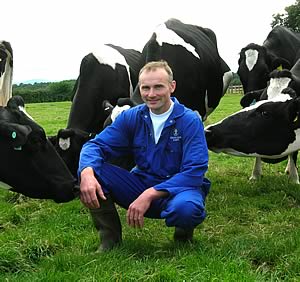 |
|||||||||
|
|||||||||||||||||||
Gold Cup finalist 2005, Nils Kurkutakis - Grosvenor
Managing director Mark Roach and head herdsman Nils Kurkutakis, along with assistant herdsmen David Carr and Mike Morris, form a formidable team and one whose efforts have seen the 305-cow herd, based at Chapel House Farm, take a well-earned place in the final six vying to win this year's coveted award. And their enterprise, which forms part of the 2,400-hectare dairy and arable unit at Bruera in Cheshire, fits in well with the philosophy of the competition that spotlights farm management, environment policies and future planning strategies, as well as investigating the production, health and welfare status of the herd. The Holstein herd averaged 9,942kg of milk, at 3.62% butterfat and 3.15% protein. Somatic cell count (SCC) for the year ending September 2004 was 188,000 cells/ml with a Bactoscan of 28. Since then, herdsman Nils says, milk hygiene figures have improved: "We're always fine-tuning management and making changes to our systems to ensure that the herd continues to move forward," he says. The high yielding half of the herd - currently comprising 144 cows all giving between 30 and 60 litres of milk each day - is milked three times a day. "And we work hard to keep these cows especially fit and healthy and free from mastitis," says Nils. The milking routine, in the recently expanded 24:24 herringbone parlour, involves pre dipping, dry wiping, foremilking, and post spraying. And Nils says that keeping the cows standing after milking, to allow the teat canals to close, is key to mastitis prevention. "We have gates in the cow house that allow the cows to feed and drink straight after milking, but don't allow access to the cubicles." There are also going to be changes to the beds. Sand is Nils preferred material, but it is blocking some drains so later this year mattresses or mats will be installed and these will be bedded with chopped straw. "And we will continue to clean these every day and spray them with a disinfectant, just as we do with the sand beds." Tipping water troughs will also be installed, to aid cleaning. And Nils also wants to add some cow brushes, to further aid cow comfort. The cow-centred approach is working. He says that despite the big increase in yields, there has been a 50% reduction in mastitis cases since he joined the herd four years ago. "One of the secrets of our success is that we don't treat the cows like objects or money-making machines. We work hard to increase cow comfort and reduce stress and the cows reward us with less disease and more milk," adds Nils. Mark Roach handles the financial side of the dairy business and that too has gone from strength to strength. "We've consolidated the business so that, when the time is right, we can expand," he says. "We're driving costs down in order to become as efficient as possible - to be one of the top 5% most efficient UK herds is our aim. And we're 'sweating' the assets that we have - making them work harder." Diversification - making alternative use of buildings and land, or building equestrian facilities - is also on the cards, as this will spread the risk of an investment. Mark and Nils are also aiming to push the herd's average yield up to 11,000 litres: "This should serve to reduce units costs even further," says Mark. "Herd expansion is on the cards, but only when the returns will justify the additional financial risk, and that's simply not the case at the moment," he adds. |
|||||||||||||||||||

|
|
||||||||||||||||||
| home | agri-services | pedigree
pen | news | dairy | beef | machinery bps | property | organisations | site map |
|||||||||||||||||||

 Maximising cow comfort and meticulous attention to detail has seen one of Grosvenor Farm's Holstein herds enter the final round of the dairy industry's most prestigious award - the NMR/RABDF Gold Cup.
Maximising cow comfort and meticulous attention to detail has seen one of Grosvenor Farm's Holstein herds enter the final round of the dairy industry's most prestigious award - the NMR/RABDF Gold Cup.